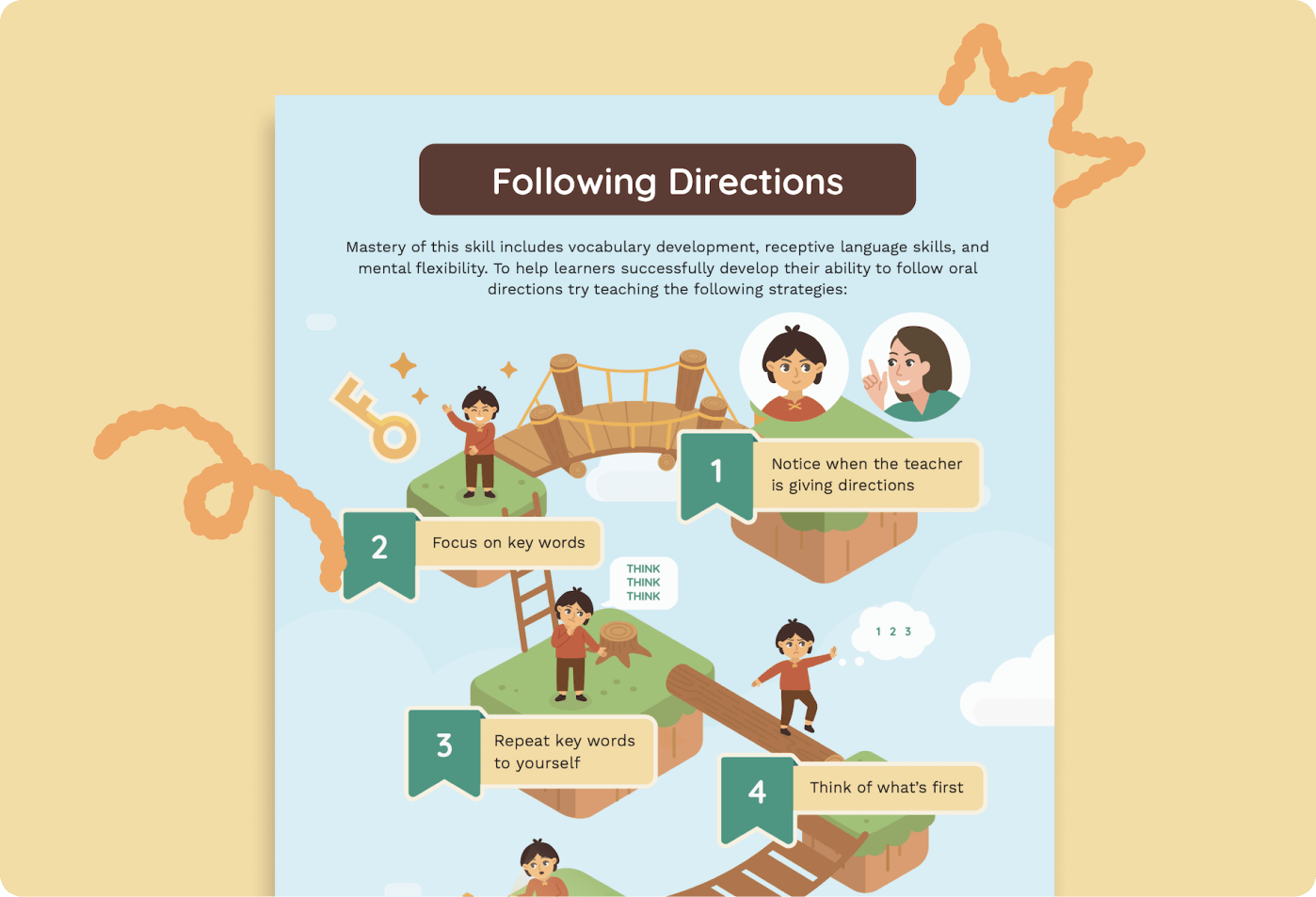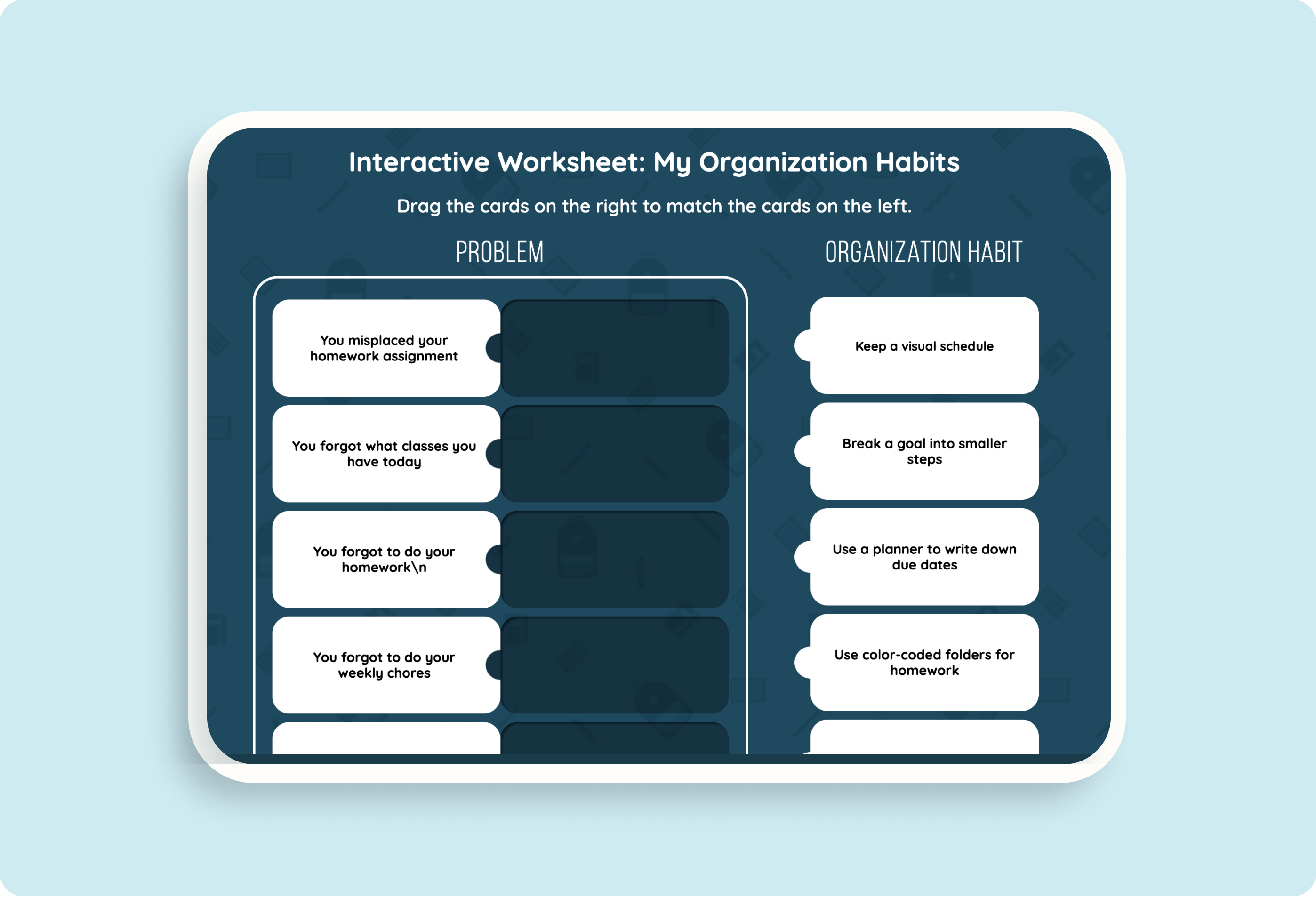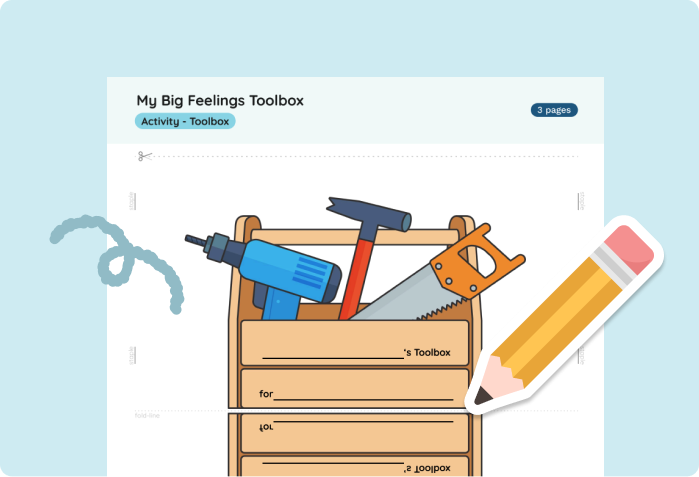Get free social skills materials
No-prep lessons on self-regulation, emotional recognition, conversation skills, and more.
Sign up hereAnxiety is one of the most common mental health challenges students face, yet it often goes unrecognized in school settings. It may show up as avoidance, emotional outbursts, frequent visits to the nurse, or complete disengagement. While educators are not expected to diagnose anxiety, they are often the first to observe how it affects learning, behavior, and participation.
Supporting students with anxiety does not require clinical training. What it does require is consistent, skills-based support delivered through everyday routines. In many cases, these strategies are already part of what student support teams do, especially in the areas of communication, behavior, and emotional regulation.
This article outlines how anxiety commonly presents in school-aged students and offers four instructional strategies that can help. Each one focuses on building observable, teachable skills. Social skills instruction plays a central role by giving students the language and confidence to manage stress more effectively.
How Anxiety Manifests in School-Aged Students
Anxiety rarely presents in a straightforward way. Students may not verbalize their stress, and many lack the language or confidence to name what they are experiencing. As a result, anxiety often shows up through patterns of behavior and communication that are easily misunderstood.
Common signs include:
- Avoidance of academic tasks or group work
- Emotional outbursts during transitions or when routines change
- Frequent nurse visits with no physical explanation
- Perfectionism, task refusal, or difficulty getting started
- Withdrawal from social situations or classroom discussions
- Irritability, defiance, or sudden clinginess
These behaviors are often labeled as oppositional or disruptive. In reality, they may reflect a student’s limited ability to manage internal stress — and a need for more structured support.
Why Skill-Based Strategies Matter for Managing Anxiety
Students are often told to “calm down” or “use coping strategies,” but many have never been explicitly taught how to do those things. When anxiety shows up in school settings, it’s rarely about a single trigger. More often, it reflects a skills gap — the student doesn’t have the tools to regulate, communicate, or adapt in the moment.
This is where school-based specialists play a critical role.
By teaching concrete, observable skills — such as how to request a break, navigate uncertainty, or recover from a mistake — educators can help students manage anxiety without needing a formal intervention plan or outside referral.
Skill-based strategies are especially effective because they:
- Focus on what’s teachable and repeatable
- Give students a sense of control in situations that feel overwhelming
- Reinforce long-term independence and resilience
In the next section, we outline four instructional strategies that address common barriers for students experiencing anxiety. Each includes practical examples that specialists can implement right away.
Strategies to Help Students Manage Anxiety at School
The most effective school-based supports for anxiety are rooted in skill-building — not just emotional validation or behavioral redirection. These four strategies reflect what student support teams can implement within their existing practice, using instructional moments to give students tools that reduce stress, increase confidence, and promote long-term independence.
1. Provide Predictability and Structure
Uncertainty fuels anxiety. Predictable routines don’t just help the classroom run smoothly — they help students know what to expect and how to respond.
What this can look like:
- Use visual schedules with “safe words” or icons for break times. Let students preview changes in routine before the day begins.
- During transitions, narrate what’s happening next: “We’ll finish this worksheet in five minutes. Then we’ll line up for music. If that feels hard today, remember your reset card is available.”
- Offer clear expectations and consistent start-of-session routines, especially for students in pull-out or small-group settings.
- For unstructured times (recess, lunch), work with students to map out what they can do, rather than focusing on what they shouldn’t. Use a checklist or “My Plan” card they carry with them.
Try these supports with students:
Visual Support: Following Directions Poster
The Following Directions Poster breaks down classroom routines into clear, manageable steps to reduce stress and increase task success. Review it with students before transitions or new routines, and keep it visible during group work or independent tasks.
Printable Worksheet: My Organization Habits
The My Organization Habits Worksheet helps older students reflect on and improve their executive functioning routines. Use it as a goal-setting tool during advisory or counseling sessions to create structure from the inside out.
2. Teach Social Skills That Support Coping and Communication
Many students experiencing anxiety don’t yet know how to name what they’re feeling — let alone what to do about it. Social skills instruction helps make the invisible visible and gives students the words and routines to manage stressful moments.
What this can look like:
- Model and practice “I need” statements: “I need a break,” “I need help,” “I need space.”
- Use video modeling or role-play to rehearse common anxiety triggers — missing directions, entering a group, unexpected changes — and walk through coping options together.
- Incorporate emotion check-ins with structured next steps. For example, students might choose from: 1) belly breathing, 2) asking for help, or 3) using their “reset” strategy.
- Teach peer communication strategies, like how to exit a game respectfully or express that something is too loud, so students have more options than shutdown or outburst.
Try these supports with students:
Video Modeling: Finding Strategies That Work for You
The Finding Strategies That Work for You video modeling lesson helps elementary students identify which calming strategies are most effective for them across different settings. Use it to start a classroom conversation or small-group activity on personalizing coping tools.
Video Modeling: Anxiety 101
The Anxiety 101 video modeling lesson introduces middle and high school students to how anxiety works, why it shows up, and what they can do about it. Use it as a primer before teaching communication and regulation strategies so students better understand what they’re working to manage.
3. Embed Regulation Strategies Into Daily Routines
Students need consistent access to regulation tools — not just when a meltdown is brewing, but throughout the day to stay ahead of stress. When regulation is part of the routine, it becomes easier for students to use those strategies when they need them most.
What this can look like:
- Begin sessions or group time with one minute of movement or deep breathing — model how to use these tools before stress escalates.
- Create a shared anchor routine for when a student starts to escalate: a visual “pause” card, a predictable breathing script, or a silent cue with a partner.
- Use sensory breaks proactively, especially after high-demand tasks or noisy transitions. Keep a consistent structure (e.g., 5 minutes, 3 steps) to avoid overstimulation.
- Coach students on body-awareness skills: “What does your body feel like when you’re starting to get frustrated? What can you try before it gets too big?”
Try these supports with students:
Video Modeling: Staying Calm When I’m Angry
The Staying Calm When I’m Angry video modeling lesson teaches younger students how to recognize physical signs of escalation and use calming strategies like breathing and counting. Watch and practice together during a morning meeting or small-group time.
Video Modeling: Choosing Calm
The Choosing Calm video modeling lesson for middle and high school models how to pause and make thoughtful decisions in high-stress moments. Pair it with reflection prompts or discussions around peer conflict, test anxiety, or unstructured time.
4. Support the Development of Agency
Anxiety often stems from feeling like things are happening to you — and there’s nothing you can do about it. Building agency helps students see that they have options, and that their choices matter.
What this can look like:
- Co-create a personal “toolbox” with students. Let them choose which strategies they want to use when they feel overwhelmed — then practice using them in low-stress situations.
- In reflection routines, shift from “How did that go?” to “What did you do that helped?” Help students see their role in their own success.
- Use checklists with steps for handling tricky moments — e.g., “When I miss directions: 1) Ask a peer, 2) Look at the board, 3) Ask the teacher.” These build internal scripts over time.
- Encourage goal-setting with frequent, achievable wins. “Today I’m going to raise my hand one time in group.” Celebrate when they follow through, even if it’s hard.
Try these supports with students:
Interactive Activity: Big Feelings Toolbox
The Big Feelings Toolbox provides young learners with visual strategy options like belly breathing, “I feel” words, and break cards. Introduce the toolbox during calm moments, and model how to choose a strategy before emotions escalate.
Video Modeling: Self-Advocacy
The Self-Advocacy video modeling lesson helps middle and high school students learn how to identify their needs and communicate them clearly. Use it as a foundation for IEP preparation, counseling sessions, or group discussions around independence and student voice.
Final Thoughts: Supporting Anxiety Through Skill-Building
Helping students manage anxiety begins with instruction, not intervention. When students learn how to name what they are feeling, express their needs, and use strategies to stay regulated, they build confidence that carries into other areas of their lives.
The strategies shared in this article are designed to support that growth. By focusing on structure, communication, regulation, and agency, educators can give students tools they can rely on in the moment and return to over time. These are not one-time fixes. They are foundational supports that help students participate, connect, and recover when anxiety becomes overwhelming.
Social skills instruction is key to this process. It helps students communicate what they need, work through challenges, and take action during moments of stress. When these skills are taught explicitly and practiced regularly, students are more likely to stay engaged and feel successful in the classroom.



